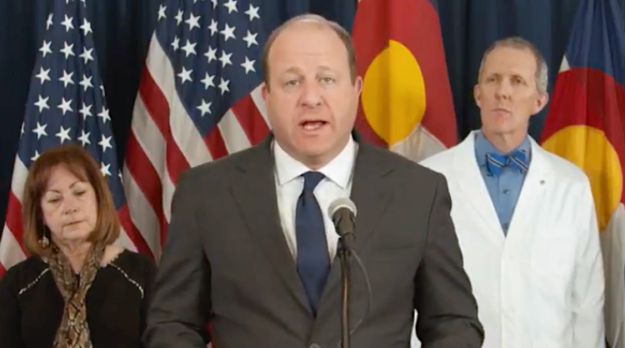Widgetized Section
Go to Admin » Appearance » Widgets » and move Gabfire Widget: Social into that MastheadOverlay zone
Colorado Gov. Polis: Healthy, vaccinated Coloradans can start to return to their ‘normal lives’

Healthy and vaccinated Coloradans can begin getting back to their “normal lives.”
That was the message from Gov. Jared Polis on Friday as he announced during a press conference the state’s transition to the “next chapter” of the COVID-19 pandemic. Improving conditions in the state, just short of the two-year anniversary of the first COVID-19 cases in Colorado, allow residents to resume a post-emergency way of life.
“For the first time in two years, we’re seeing a semblance of normality, as resistance to the virus has reached over 91% of Coloradans through either prior infection or full vaccination,” Polis said.
Polis appeared at the press conference with several other public health officials, including Colorado Department of Public Health and Environment Executive Director Jill Hunsaker Ryan, the department’s Chief Medical Officer Dr. Eric France, and state COVID-19 incident commander Scott Bookman.
None wore a mask as they stood shoulder-to-shoulder with Polis.
“What we’re really indicating today is the people of Colorado should view the emergency phase of this virus as over,” Polis said.
The officials described various conditions that allow the state to start getting back to normal: More than 90% of Coloradans have some degree of immunity from the omicron variant and the most serious disease. The state has the 10th-lowest COVID-19 death rate in the country. And it has dramatically ramped up its ability to test for the coronavirus.
“If you’re fully vaccinated, especially if you’re up to date with all your vaccines, you can feel comfortable living life as normal,” Polis said.
The officials presented a “Roadmap to Moving Forward,” which outlined next steps in the state’s response to the coronavirus.
Colorado officials announced the state’s first two cases of the coronavirus on March 5, 2020. Since then, life in the state, as in most places around the globe, has been anything but normal. On March 25 of that year, Polis issued a stay-at-home order, as the pandemic presented a growing risk to public health and the capacity of the state’s hospitals to handle a surge of critically sick people.
Polis’ approach to the pandemic began to pivot on Dec. 14, 2020, the day the first doses of vaccine arrived in the state. By July 2021, when 70% of Colorado adults had received at least one vaccine dose, he declared the end of the state’s “health emergency.”
The delta and omicron variants, plus misinformation and resistance to vaccines among a sizable portion of the population, have presented speed bumps on Colorado’s road to normalcy. But Polis established a record of being ahead of other Democratic governors in easing pandemic restrictions, even as the omicron wave of infections threatened to overwhelm hospitals.
State officials cautioned on Friday that people who are immunocompromised, unvaccinated or otherwise at high risk still must take precautions. And a new variant could necessitate a broad return to protective measures. COVID-19 will probably be around “for the rest of our lives,” Polis said.
But current circumstances allow at least “a breather,” Ryan said.
“You’ve done your part, Colorado. And you’ve earned the right to move beyond the pandemic in your lives,” Polis said.
The “roadmap” the officials presented features four main efforts as the state moves forward: hospital readiness, public health readiness and surge planning, health care workforce expansion, and working with the federal government on reforms to better handle the ongoing need to respond to COVID-19, especially to bolster testing capacity and the health care workforce.
In Colorado, 12,428 people have died due to COVID-19. As of Wednesday, there were an average of 780 daily new cases in the state over a seven-day period. That’s way down from a peak of 13,932 in early January.
Editor’s note: This story first appeared on Colorado Newsline, which is part of States Newsroom, a network of news bureaus supported by grants and a coalition of donors as a 501c(3) public charity. Colorado Newsline maintains editorial independence. Contact Editor Quentin Young for questions: info@coloradonewsline.com. Follow Colorado Newsline on Facebook and Twitter.
Colorado Newsline
Latest posts by Colorado Newsline (see all)
- CU Regents chair admits Benson Center ties to Eastman and Jan. 6 damaging to overall reputation - June 21, 2022
- Colorado Gov. Polis: Healthy, vaccinated Coloradans can start to return to their ‘normal lives’ - February 28, 2022
- Vail’s Donovan slams new congressional map as ‘disservice to Coloradans’ - November 2, 2021


